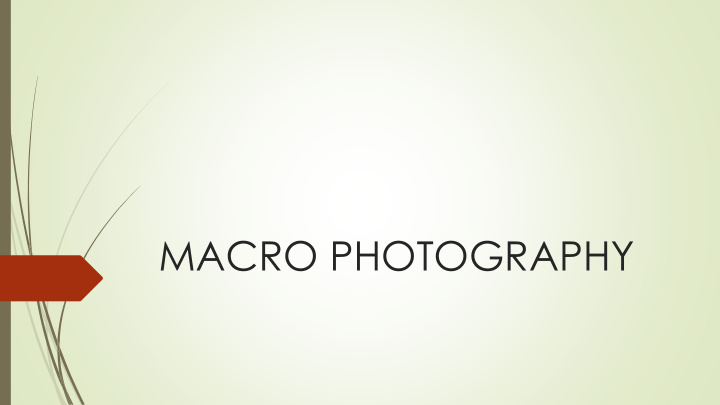



MACRO PHOTOGRAPHY
Definition Macro refers to the fact that the size of the subject is the actual size on the media. i.e. a 1:1 ratio. It also generally refers to a subject shot at close range. The subjects are often magnified to appear larger than life. Usual subjects are flowers, insects, small items or parts of a larger one.
MACRO LENSES These are specially designed lenses for extreme close ups They are sharp and high in contrast They have the ability to focus closely so that the size of the subject is the actual size on the film or sensor They have more lens elements than standard lenses They are corrected so the plane of focus is flat at short distances They come in different fixed focal lengths
F18 1/60sec ISO800 105mm lens
Macro/close up scene mode
F11 1/200 sec. ISO800 40mm lens
Depth of Field This is very important in macro photos as they have a very narrow one. It refers to what’s sharply in focus in front of and behind your subject. Four main factors affect depth of field in macro photos. 1. Aperture 2. Distance from the subject 3. Desired magnification 4.The focal length of the lens
F22 ISO400 1/60 sec Flower size-1/2 inch across
F13 1/250 sec. ISO400 105mm
Aperture = f stop – generally this is the mode I use for macro photos -the larger the number the smaller the hole and the greater the depth of field - eg. F22 will give a great deal more sharpness than f4 - The largest aperture I usually use is F11 Distance - the closer you are the shallower the depth of field - If you move the camera further away you can increase it Focal Length of Lens -there are several different ones for macro lenses made by various companies 40mm, 60mm, 85mm, 95mm, 105mm Some companies call them micro lenses Close up Filters – screw onto front of lens Extension tubes – fit between the lens and camera and help magnify the subject
The depth of field decreases as you try to increase the size of your subject Use a smaller aperture ( larger #) to increase DOF This also means you need more light a slower shutter speed, higher ISO or flash are needed to compensate Often necessitates the use of a tripod A remote trigger or self timer reduces hand shake A piece of equipment called a focus rail could also be used on your tripod
All the parts of your subject you want in focus need to be on a plane that is parallel to and equidistant from the lens- especially insects F4 ISO400 1/4000 sec. 40mm lens
F18 1/60 sec. ISO800 105mm
Lighting Outdoors – earlier or later in the day- direct light overhead is harsh Fill flash can be used but it can create shadows Ring light or 2 sided macro light Watch for shadows from other objects
The pop up flash was used to create the dark background. F22 1/60 sec ISO200 40mm lens
F16 1/60 sec ISO400 40mm lens Pop up flash
OTHER CONSIDERATIONS Use center weighted or spot metering Concentrate on the feature you want to be prominent- make sure that’s where your focus is Watch for distractions Try different positions – above, below, from the side Wind Fill the frame Be prepared to crop
F16 1/125 sec ISO400 40mm
F20 1/125 sec. ISO500 40mm
F22 1/90sec ISO800 105mm
F13 1/160sec F11 ISO400 1/500 sec. 40mm ISO400 105mm Cropped to show bee better
F20 1/400 ISO800 105mm
F20 1/400 sec ISO800 105mm
F20 1/60 sec ISO200 105 mm Flash on
F16 1/80sec ISO400 40mm Flash on
Sony P&S Close up mode
F14 1/400 sec. ISO400 40mm
Thank You! Lynn J. Dukelow 2018
Recommend
More recommend